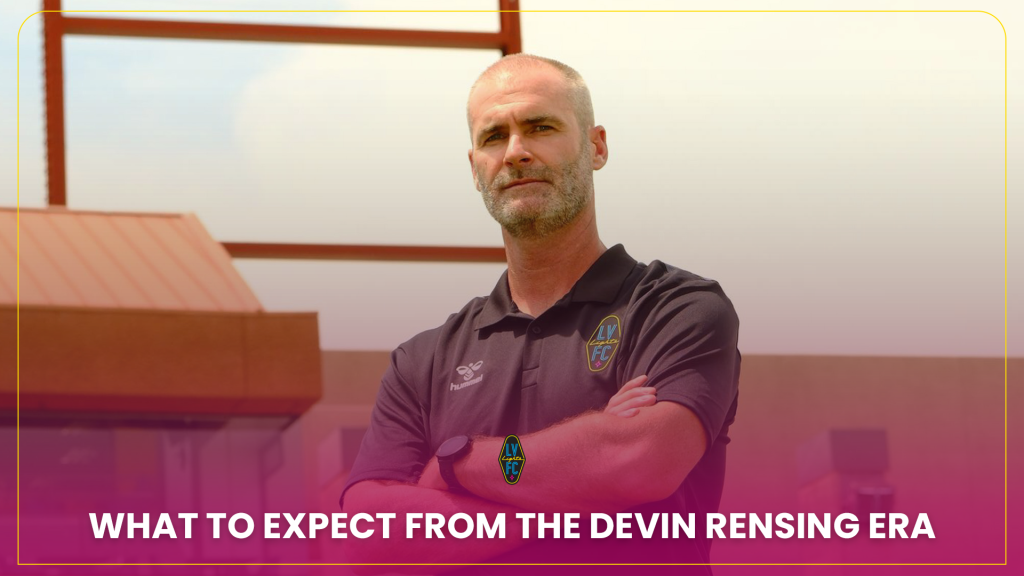Ahead of his coaching debut on Saturday, get to know the Lights’ new head coach: his ideas, principles, and tactical preferences.

Las Vegas, Welcome to the Devin Rensing Era
A new era has begun. Devin Rensing is the new Head Coach of Las Vegas Lights FC.
This will be Rensing’s first time as a head coach for a professional soccer club, having spent most of his career as a head coach in college soccer and as an assistant coach to Ben Pirmann in the USL Championship with Memphis 901 FC and the Charleston Battery.
Because of this, it’s not as straightforward to identify and show what Rensing’s playing style will be as it would be for a head coach with multiple seasons of clear results to analyze.
However, the setup is intriguing. The Lights are currently last in the Western Conference standings, four points shy of playoff qualification. Rensing now brings a fresh set of principles and concepts to revamp the Lights in an effort to turn playoff aspirations into reality.
But as the old adage goes: Rome was not built in a day. It will take more than a week of training sessions for his ideas to come alive and become super clear for fans to see.
Still, his conversation during Episode 17 of The Lights Lounge, his first press conference as Lights Head Coach, and a careful analysis of his work alongside Ben Pirmann at Memphis 901 FC and Charleston Battery offers us some insight into how the team might look in the near future.
Let’s dive in.
Non-Negotiables
“I always want our team to be high character, high energy.”
For Devin Rensing, hard work is a must. He wants his teams to relentlessly pursue the ball when it’s not under their control. He wants a squad that outworks the opposition when talent just doesn’t seem to cut it.
“High energy means you’re going to run. You’re going to work. You’re going to hunt that ball,” Rensing said. “High character I think is very, very important. Something as simple as a call that’s not going your way, and you’re not complaining to the ref. You’re not looking for excuses. You get up and move on with it. You make a bad pass, or a teammate makes a bad pass, and you just get on with it.”
High energy (backed up by high character) is a persistent desire to outperform one’s rival.
But this effort, as Devin Rensing himself acknowledges, must be a calculated one. Given the weather conditions in Las Vegas and in other cities of the Western Conference, playing high energy soccer for 90 minutes is not always reasonable.
Sometimes the team will have to fall back into a mid-block or perhaps a low block. This balance allows the team to retain tactical flexibility when the match state calls for a different approach.
Still, the burning impulse of going for victory must remain for Rensing’s players regardless of the tactical shape the team takes.
Under Pressure. Them. Not Us.
“Defending higher up the field is all about structure; understanding where to press and when to press and having the energy and courage to go do it. And then, you have to have balance in the back.”
During the first few months of competition, the Lights maintained a low-pressure style of play. The team would keep a compact low block, with two or three players leading any potential counterattacks after opposition turnovers.
This had a couple of problems. First, the team was often too stretched: the distance between midfield and forwards was too long, and those hypothetical turnovers were rarely transforming into high-quality scoring opportunities.
The second issue was space: the opposition had too much space to build up comfortably and generate chances. Intelligent passing could lure the back line out of position and create numerical superiorities to create key opportunities for their forwards.
It looks like the philosophy will be different under Devin Rensing. He wants to keep a high defensive line, with the forwards and midfielders pressing aggressively during the rival’s build-up phase. This allows the team to be a lot more compact while generating quick scoring opportunities through turnovers higher up the field.
Does this approach have its risks? Of course it does.
However, Rensing’s balanced approach to pressing, where every single player is involved in making sure the rival is never comfortable and the team can sit back in a mid- or low-block when necessary, will be the answer.
Football: Rensing Style
Pirmann and Rensing’s most used formation throughout their time working together at Memphis and Charleston was the 4-2-3-1. In their iteration of the 4-2-3-1, you have:
- A classic back four with two center backs who are heavily involved in build-up play
- A double pivot made up of central midfielders who know how to defend well in 1v1 situations but are also great on the ball
- Two agile wingers who give the team width, depth, and the possibility of cutting into the box when needed
- A false nine/playmaker hybrid who drops into midfield to assist and generate chances
- A classic, target number nine.
If we analyze any of Charleston Battery’s 2025 matches, we can see this tactical setup come to life. Given that Rensing has spent his entire professional coaching career with Ben Pirmann, it’s reasonable to analyze those teams and expect similarities here in Vegas.
Let’s take a look at Irishman Aaron Molloy, who is a locked-in starter in the Battery’s double pivot, for a window into how Rensing wants his midfielders to operate.
Molloy’s objective is not only to interfere with the opposition’s attacks by supporting their high press, but also to generate chances via precise passing and the occasional long ball.
Devin Rensing likes to keep possession and open up space via possession, but sometimes long balls are the ideal way to beat a tight defensive line and find your target man in a great position. This is why, alongside being the second most accurate passer per 90 in the league, Molloy is the sixth-best in the Championship when it comes to long balls per match.
“You gotta do what you gotta do” if what you want to do is win.
Charleston’s attack is without a doubt its strongest sector, leading the league in xG per match (1.59) and goals scored (38). They have utilized an interesting front four to generate this danger.
Most often, you’ll see Arturo Rodriguez and Juan David Torres as constant threats on the wings for the Battery. Expect the wingers for the Lights to be given the freedom to cut inside, crash the box, and swap sides as needed to create big moments, just like the Battery has done with their wide players.
And finally, the way Pirmann and Rensing approached their strikers in Charleston is quite unique in this league. Rather than utilize just one number nine with a classic, playmaking number 10 underneath, they often play with two forwards filling distinct roles.
One striker plays a “false nine” while the other plays as a more traditional target man.
Cal Jennings is the Battery’s “false nine”: a hybrid between a playmaker and a striker. A USL Championship legend (and former Lights player) known for being a voracious goal scorer, Jennings’s role involves engaging in dirty work and going a bit deeper into midfield to assist with distribution and chance creation.
That doesn’t mean the player in this role can’t score goals. In fact, Jennings has done so 11 times this season, making him tied for the Championship’s top scorer lead as he crashes the box.
MD Myers usually plays as a traditional nine, occupying the center backs and holding up the ball during build-ups. He then attacks the box and finishes chances (8 goals this season) with surgical precision (that’s a medical joke for you).
Given the success of this attacking system in Charleston, expect to see something similar potentially deployed in Rensing’s first few matches in charge of the Lights. Ultimately, it will be interesting to see how he matches up the profile of players he has on this Las Vegas roster with the roles in his preferred tactics.
The New Lights
Now, why should Lights fans take interest in Rensing’s principles, formations, and tactics? Well… because they shed light on how the Lights might stand this Saturday and beyond.
No squad is the same, and context matters. Tactics can be tweaked responding to particular constraints, and individual roles can be modified. But, principled coaches tend to remain faithful to their deeply held ideals.
So, what can we expect from the Lights here on out?
Rensing’s 4-2-3-1 is not set in stone, but we can most likely expect a system akin to that one, which would be a departure from the back three the Lights got used to at the start of the season.
We can expect a more intense team with a balanced but firm press that keeps rivals on guard.
However, perhaps most importantly, we can expect a high character, high energy team that fights for every ball as if it were the last one, firmly embodying the values that Devin Rensing has honed through his two decades of coaching experience.


























































































































































































































































































